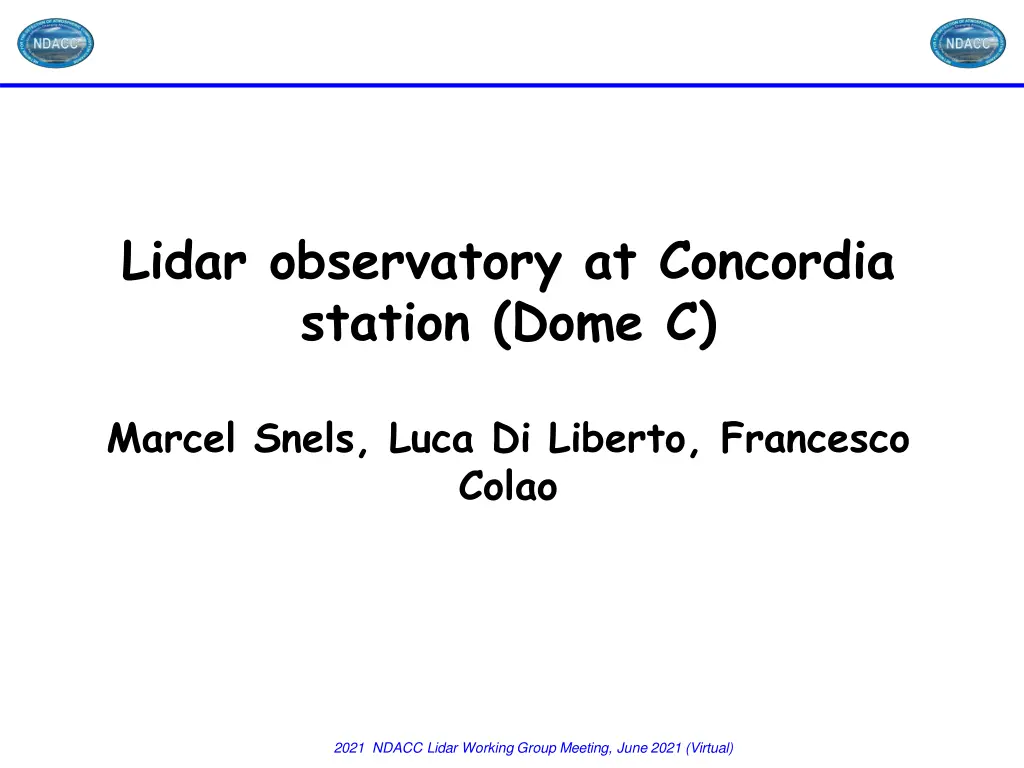
Stratospheric Lidar Operations at Concordia Station - Insights and Innovations
Discover the operational journey of the stratospheric lidar at Concordia Station, Dome C, including challenges faced, equipment upgrades, and recent observations of Polar Stratospheric Clouds (PSCs). Explore the latest publications showcasing comparisons between ground-based lidar and satellite observations, shedding light on PSC detection and composition.
Download Presentation

Please find below an Image/Link to download the presentation.
The content on the website is provided AS IS for your information and personal use only. It may not be sold, licensed, or shared on other websites without obtaining consent from the author. If you encounter any issues during the download, it is possible that the publisher has removed the file from their server.
You are allowed to download the files provided on this website for personal or commercial use, subject to the condition that they are used lawfully. All files are the property of their respective owners.
The content on the website is provided AS IS for your information and personal use only. It may not be sold, licensed, or shared on other websites without obtaining consent from the author.
E N D
Presentation Transcript
Lidar observatory at Concordia station (Dome C) Marcel Snels, Luca Di Liberto, Francesco Colao 2021 NDACC Lidar Working Group Meeting, June 2021 (Virtual)
The stratospheric lidar is operative from 2014 and produced data for 5 years. We have two identical lasers, to allow for maintaince in Europe every two or three years. In 2017 one of the two lasers broke down and was substituted with the spare. Unfortunately the laser was beyond repair and we bought a new laser of the same model. In summer 2018/2019 the new laser (Quantel CFR400) was installed but refused to emit radiation in the vertical position. So it was returned to the supplier and we remounted our spare laser. Unfortunately the spare laser broke down in May and we did not take any measurements in 2019. In 2020 we mounted the new laser in a horizontal position, while using a mirror at 90 degrees, and recorded regular measurements from July on after some alignment problems. In summer 2020/2021 we substituted the mirror mount with a piezo mount which can be remotely controlled. Now the full lidar system is remotely controlled, including fine alignment. The measurements started on 18/05/2021 and we observed the first PSCs around 22-23 km on 29/05/2021 2021 NDACC Lidar Working Group Meeting, June 2021 (Virtual)
Archiving status All data have been archived from 2014-2018 2019 data are absent due to laser failure 2020 data have been uploaded to the new site on 29/04/2021 2021 NDACC Lidar Working Group Meeting, June 2021 (Virtual)
NEW PUBLICATIONS: 1) Marcel Snels, Francesco Cairo, Luca Di Liberto, Andrea Scoccione, Marco Bracaglia, Terry Deshler, Comparison of Coincident Optical Particle Counter and Lidar Measurements of Polar Stratospheric Clouds above McMurdo (77.85oS, 166.67oE) from 1994 to 1999. , Journal Of Geophysical Research Atmospheres, 126, 6, 2021 2) Marcel Snels, Francesco Colao, Francesco Cairo, Ilir Shuli, Andrea Scoccione, Mauro De Muro, Michael Pitts, Lamont Poole, Luca Di Liberto, Quasi- coincident observations of polar stratospheric clouds by ground-based lidar and CALIOP at Concordia (Dome C) from 2014 to 2018 , Atmospheric Chemistry and Physics 21, 2165-2178, 2021 3) InesTritscher, Michael C. Pitts, Lamont R. Poole, Thomas Peter,S. P. Alexander, F. Cairo, M. P. Chipperfield, J.-U. Groo , M. H pfner, A. Lambert, B. P. Luo, S. Molleker, A. Orr, R. Salawitch, M. Snels, R. Spang, W. Woiwode Polar Stratospheric Clouds: Satellite Observations, Processes, and Role in Ozone Depletion , Review of Geophysics, 04 April 2021, https://doi.org/10.1029/2020RG000702 2021 NDACC Lidar Working Group Meeting, June 2021 (Virtual)
Quasi-coincident observations of polar stratospheric clouds by ground-based lidar and CALIOP at Concordia (Dome C) from 2014 to 2018. Comparison and detection and composition of PSCs as observed by ground-based lidar and CALIOP. Comparison of gb lidar with nearest CALIOP profile within 100 km and 30 minutes Main conclusions: The overall agreement is good The Concordia area has rather homogeneous PSCs 1) Detection. In 75 % of all cases both lidars detect/do not detect a PSC. In 19 % only gb lidar detects a PSC , in 6 % only CALIOP detects a PSC. The explanation: The gb lidar has a slightly lower threshold for R. The different acquisition time of the lidars. ( seconds vs minutes) 2) Composition. Gb lidar detects more NAT. Explanation: Different acquisition time. STS = orange, NAT = green, Enhanced NAT = red, Ice = blue 2021 NDACC Lidar Working Group Meeting, June 2021 (Virtual)
Future plans : Repair spare laser (waiting for funding) All parts of the observatory have been recently updated and spare parts are available, being an observatory operation is guaranteed for the next future. CIRCE (Cirrus Lidar Concordia Experiment) project has been approved for two years New telescope for cirrus cloud observation, with polarization channel will be installed next summer. 2021-2022 . YOPP (Year of Polar Prediction) SH proposal water budget and precipitation in Antartica: A possible contribution to YOPP-SH winter Special Observation Period (SOP) 2021 NDACC Lidar Working Group Meeting, June 2021 (Virtual)

